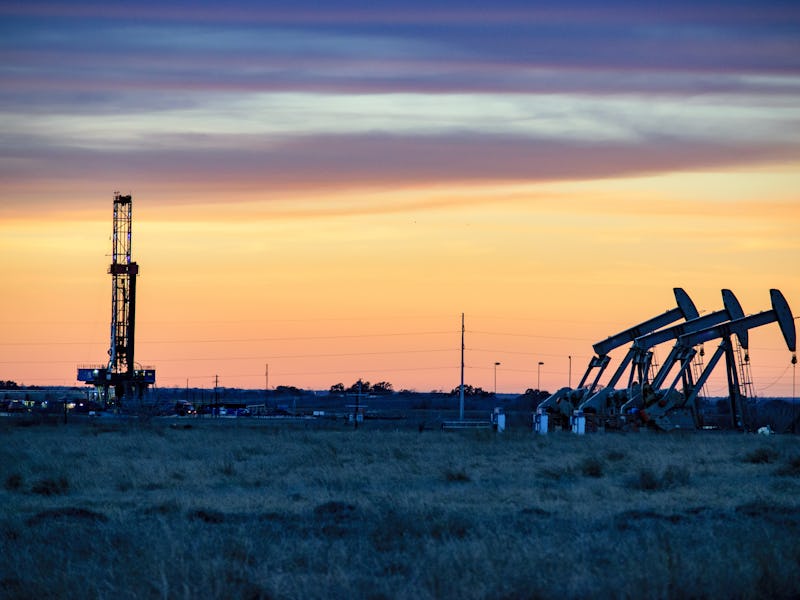Satellites capture shocking quantity of greenhouse gas leaking from Permian Basin
It's enough to supply 7 million households in Texas.

A recent set of data collected by European Space Agency (ESA) satellites revealed just how much damage is being caused by one of the world's largest oil production regions in the United States.
A team of scientists analyzed the satellite data, and found that around 2.7 teragrams (more than two trillions grams, or a little over 5,952,481,078 pounds) of methane was leaking from Permian Basin each year, which is 60 percent higher than the national average and contributes the same amount of carbon dioxide emissions as all U.S. residences combined.
Additionally, the amount of gas leaking from Permian Basin is enough to supply seven million households in Texas, according to the researchers.
The above illustration shows the average methane mixing ration over the U.S.
The study was published Wednesday in the journal Science Advances.
The Permian Basin is a sedimentary basin, meaning that some time between 1.3 billion to 850 million years ago, tectonic plate activity created a shelf of rock underneath the Earth's surface, essentially trapping a variety of fluids, gasses, and minerals. Over a billion years later, people began to convert these trapped elements into petroleum and natural gas. The Permian Basin is one of the world's largest sedimentary basins, and is located in the Southwestern U.S, across western Texas and southeastern New Mexico. In early 2019, Permian Basin surpassed Saudi Arabia's Ghawar oil field, producing 4.2 million barrels of oil a day, according to Forbes.
The production of oil in Permian Basin has increased by four and 2.5 times between the years 2007 and 2018, and the region now supplies 30 percent of the nation’s crude oil and 10 percent of its natural gas. But scientists believe that this production also allows methane, which has been trapped within the basin, to escape at previously unseen levels.
However, the amount of greenhouse gases released by Permian Basin has so far remained unknown.
Methane is a greenhouse gas that absorbs the Sun's heat, thereby warming the atmosphere. When it is leaked into the atmosphere, methane is a major contributor to global warming.
In order to calculate the amount of greenhouse gas that is being leaked from Permian Basin, the team of scientists looked at 11 months worth of data collected by the Visible Infrared Imaging Radiometer Suite (VIIRS) instrument onboard the Suomi National Polar-Orbiting Partnership satellite.
Using the satellite data, the scientists measured the amount of methane in the atmosphere over the U.S., and specifically looked at greenhouse gas emissions from Permian Basin between 2018 and 2019.
The graph shows the increase in greenhouse gas emissions over the years.
The dramatically high amount of greenhouse gas emissions being leaked from Permian Basin could be attributed to the region's poor infrastructure that leads to inefficient gathering, processing and transportation of the natural gas, according to the study.
Satellite data is often crucial in revealing valuable measurements of pollutants in the Earth's atmosphere, and the recent study shows that this type of method could be used to routinely measure methane emissions from various oil producing regions around the world.
The team of researchers behind the new study hope that this data can help reduce the amount of methane leaking from Permian Basin in the future by improving the site's design, infrastructure and regulation.
Abstract: Using new satellite observations and atmospheric inverse modeling, we report methane emissions from the Permian Basin, which is among the world’s most prolific oil-producing regions and accounts for >30% of total U.S. oil production. Based on satellite measurements from May 2018 to March 2019, Permian methane emissions from oil and natural gas production are estimated to be 2.7 ± 0.5 Tg a−1, representing the largest methane flux ever reported from a U.S. oil/gas-producing region and are more than two times higher than bottom-up inventory-based estimates. This magnitude of emissions is 3.7% of the gross gas extracted in the Permian, i.e., ~60% higher than the national average leakage rate. The high methane leakage rate is likely contributed by extensive venting and flaring, resulting from insufficient infrastructure to process and transport natural gas. This work demonstrates a high-resolution satellite data–based atmospheric inversion framework, providing a robust top-down analytical tool for quantifying and evaluating subregional methane emissions.